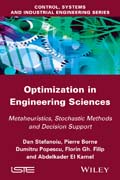
Optimization in Engineering Sciences: Approximate and Metaheuristic Methods
Borne, Pierre
Philip, F. G.
Popescu, Dumitru
Stefanoiu, Dan
El Kamel, Abdelkader
The purpose of this book is to present the main metaheuristics and approximate and stochastic methods for optimization of complex systems in Engineering Sciences. It has been written within the framework of the European Union project ERRIC (Empowering Romanian Research on Intelligent Information Technologies), which is funded by the EU’s FP7 Research Potential program and has been developed in co–operation between French and Romanian teaching researchers. Through the principles of various proposed algorithms (with additional references) this book allows the reader to explore various methods of implementation such as metaheuristics, local search and populationbased methods. It examines multi–objective and stochastic optimization, as well as methods and tools for computer–aided decision–making and simulation for decision–making. INDICE: 1. METAHEURISTICS, LOCAL SEARCH 1.1. Hill Climbing 1.2. Tabu Search 1.3. Simulated Annealing 1.4. Tunneling 1.5. Algorithms with Penalties 1.6 GRASP METHOD 2. METAHEURISTICS, POPULATION– BASED METHODS 2.1. Evolutionary Algorithms 2.2. Genetics Algorithms 2.2.1. Biologic Breviary 2.2.2. Genetic Algorithms Principle 2.2.3. Scheme Theorem of J. Holland 2.2.4. Vose–Liepins Algorithm with Infinite Population 2.2.5. Nix–Vose Algorithm with finite Population 2.2.6. How to implement a Genetic Algorithms 2.3. Ant Colony Optimization Algorithms 2.4. Particle Swarm Optimization 2.4.1 General Algorithm 2.4.2. Firefly Algorithm 2.4.3 Bat Algorithm 2.4.4 Bees Algorithm 2.4.5 Improved Particle Swarm Optimization Algorithm 3. MULTI–OBJECTIVE OPTIMIZATION 3.1 Pareto–optimality 3.2 Choquet Integral 3.3 Optimization with two Objective Functions 3.3.1 Identification and Optimization, Two Control Objectives 3.3.2 Aggregation of Identification and Optimization Stages 3.3.3 Problem Construction and Solution : parametric representation, variables recursive partitioning, approach on the objective functions sensitivity 4. STOCHASTIC OPTIMIZATION 4.1Problem Position 4.2 Repartition Function Calculation 4.3 Optimality Stochastic Criteria 4.3.1 Calculation of the Solution to the Stochastic Problem – Admissible Solutions Case, Minimum Risk Problem, Imposed Risk Problem 4.3.2 Calculation of Solution to the Stochastic Problem– Partially Admissible Solutions 4.3.3Case Studies 5. METHODS AND TOOLS FOR COMPUTER AIDED DECISION6MAKING 5.1. Optimal vs suboptimal solutions 5.2 Methods 5.2.1 Influence diagrams and decision trees 5.2.2 Game theory based methods 5.2.3 Multiattribute decision models 5.2.4 Other methods (Borda , Condorcet , Onicescu) 5.2.5 Combinations of numerical models and AI—based techniques 5.3. Decision Support Systems 5.4. Criteria or decision–makers ? 6. DECISION MAKING USING SIMULATION 6.1 Problem statement in environment with uncertainties 6.2. Limits of formal approaches 6.3 Benefits of simulation for decision making 6.4 Development approach 6.5 Study cases: 6.5.1 New product release 6.5.2 Stock management 6.5.3 Plane overbooking 6.5.4 Car rental 6.5.5 ATM 6.5.6 Bank placements 7. APPLICATIONS 7.1. Fuzzy reasoning and genetic optimization in manufacturing 7.2. Genetic matching pursuit for mechanical faults 7.3. Phenomena prediction by using particle swarm optimization 7.4 Optimization of a petrochemical platform 7.4.1 Technological insights and existing automation 7.4.2 Optimizing the ethylene reactor 7.5 Optimization of a thermo–energetic installation 7.5.1 Technological insights and existing automation 7.5.2 Optimizing the heating system 7.6 Optimization of combustion process in a steel making plant 7.6.1 Technological insights and existing automation 7.6.2 Optimizing the combustion process 8. CONCLUSION
- ISBN: 978-1-84821-498-9
- Editorial: ISTE Ltd.
- Encuadernacion: Cartoné
- Fecha Publicación: 04/08/2014
- Nº Volúmenes: 1
- Idioma: Inglés
